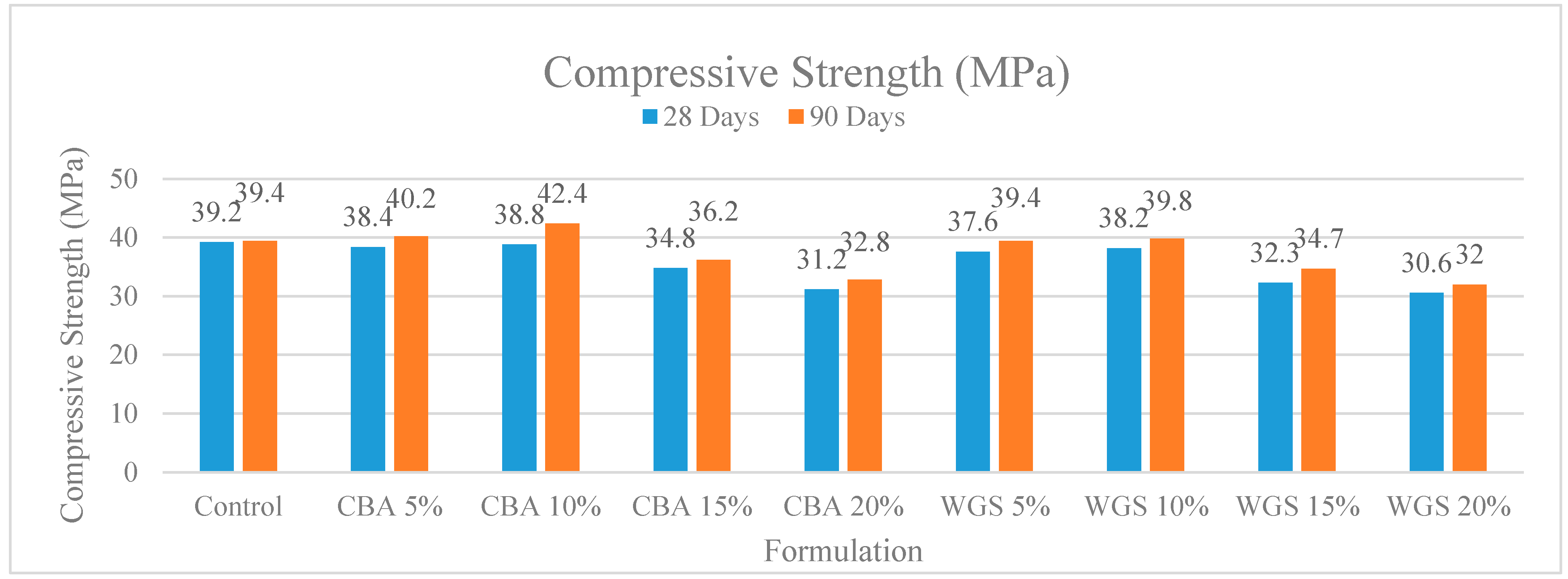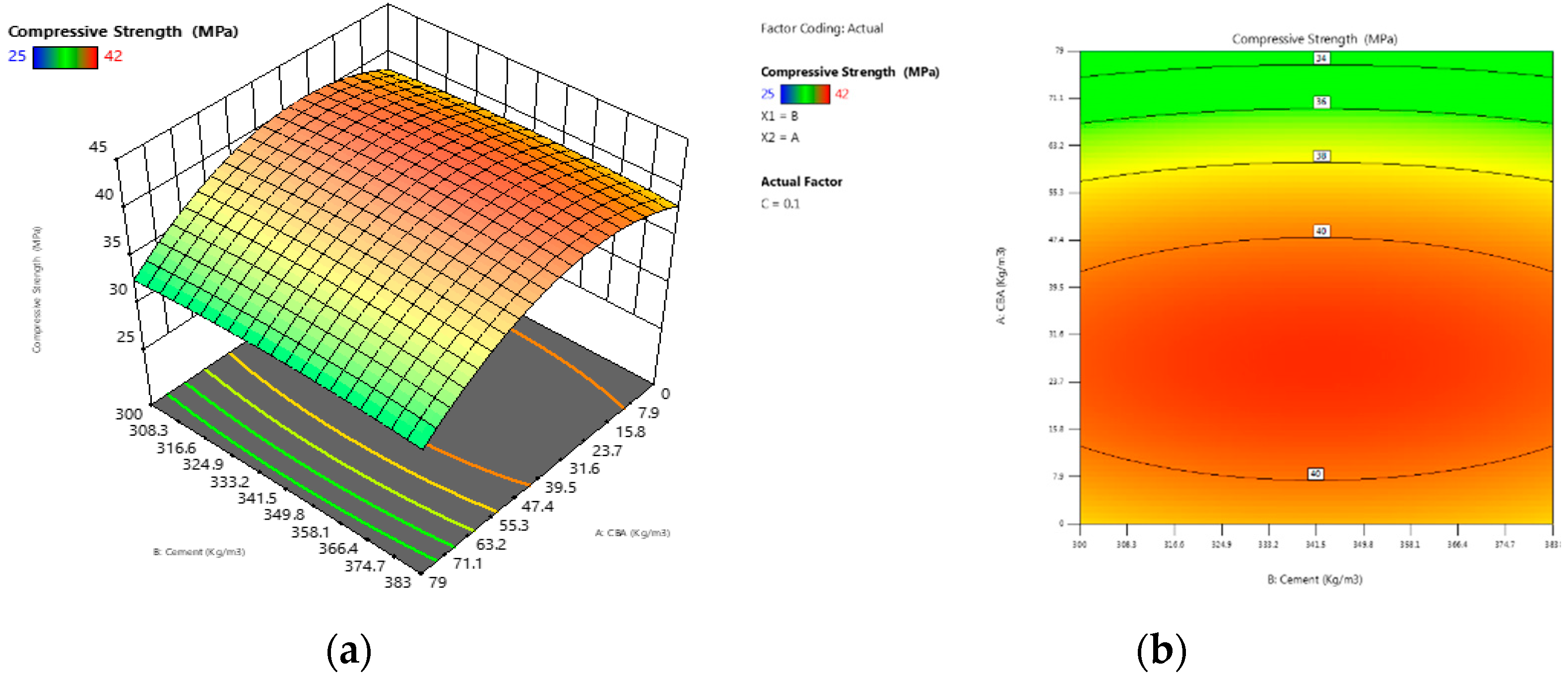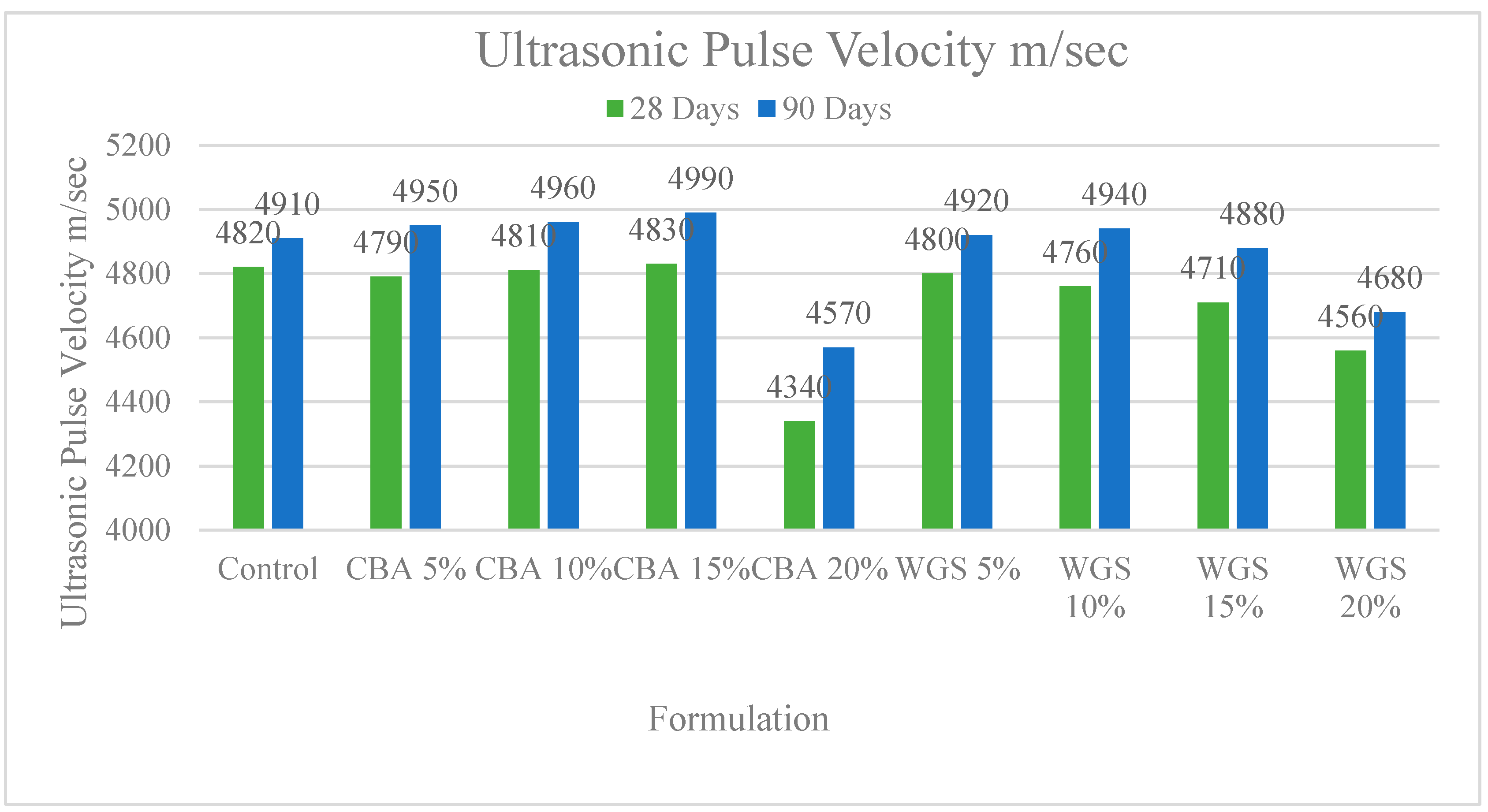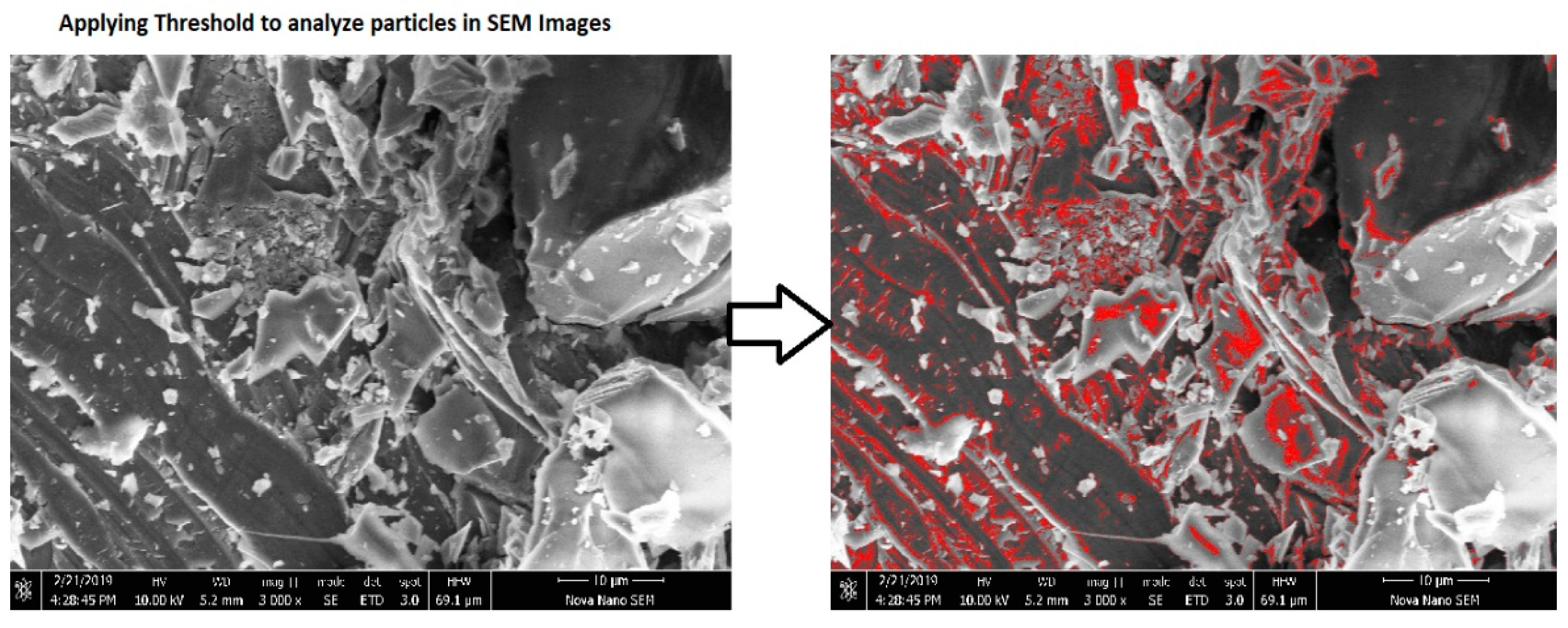An Experimental Study on Non-Destructive Evaluation of the Mechanical Characteristics of a Sustainable Concrete Incorporating Industrial Waste
Abstract
:1. Introduction
Research Significance
2. Materials and Methods
2.1. Materials and Mix Proportioning
2.2. Mixing and Casting Procedure
2.3. Testing Program
2.4. Response Surface Method
3. Results and Discussion
3.1. Compressive Strength
3.2. Ultrasonic Pulse Velocity
3.3. Compressive Strength and Rebound Hammer
3.4. Anova Analysis
3.5. Optimization and Experimental Validation
4. Microstructure Analysis by SEM
4.1. Waste Glass Sludge (WGS)
4.2. Coal Bottom Ash (CBA)
4.3. Calculation of Porosity by Analyzing Particles Using Image J Software
5. Conclusions and Recommendations
5.1. Conclusions
5.2. Recommendations
Author Contributions
Funding
Informed Consent Statement
Data Availability Statement
Conflicts of Interest
References
- Anderson, T.R.; Hawkins, E.; Jones, P.D. CO2, the greenhouse effect and global warming: From the pioneering work of Arrhenius and Callendar to today’s Earth System Models. Endeavour 2016, 40, 178–187. [Google Scholar] [CrossRef] [Green Version]
- Yildizel, S.A.; Tayeh, B.A.; Calis, G. Experimental and modelling study of mixture design optimization of glass fiber-reinforced concrete with combined utilization of Taguchi and Extreme Vertices Design Techniques. J. Mater. Res. Technol. 2020, 9, 2093–2106. [Google Scholar] [CrossRef]
- Karalar, M.; Özkılıç, Y.O.; Deifalla, A.F.; Aksoylu, C.; Arslan, M.H.; Ahmad, M.; Sabri, M.M.S. Improvement in Bending Performance of Reinforced Concrete Beams Produced with Waste Lathe Scraps. Sustainability 2022, 14, 12660. [Google Scholar] [CrossRef]
- Qaidi, S.; Najm, H.M.; Abed, S.M.; Özkılıç, Y.O.; Al Dughaishi, H.; Alosta, M.; Sabri, M.M.S.; Alkhatib, F.; Milad, A. Concrete Containing Waste Glass as an Environmentally Friendly Aggregate: A Review on Fresh and Mechanical Characteristics. Materials 2022, 15, 6222. [Google Scholar] [CrossRef] [PubMed]
- Çelik, A.I.; Özkılıç, Y.O.; Zeybek, Ö.; Özdöner, N.; Tayeh, B.A. Performance Assessment of Fiber-Reinforced Concrete Produced with Waste Lathe Fibers. Sustainability 2022, 14, 11817. [Google Scholar] [CrossRef]
- Amin, M.; Zeyad, A.M.; Tayeh, B.A.; Agwa, I.S. Engineering properties of self-cured normal and high strength concrete produced using polyethylene glycol and porous ceramic waste as coarse aggregate. Constr. Build. Mater. 2021, 299, 124243. [Google Scholar] [CrossRef]
- Breysse, D.; Balayssac, J. Non-Destructive In Situ Strength Assessment of Concrete. 2008. Available online: https://www.rilem.net/groupe/249-isc-non-destructive-in-situ-strength-assessment-of-concrete-295 (accessed on 1 January 2020).
- Hamidian, M.; Shariati, A.; Khanouki, M.M.A.; Sinaei, H.; Toghroli, A.; Nouri, K. Application of Schmidt rebound hammer and ultrasonic pulse velocity techniques for structural health monitoring. Sci. Res. Essays 2012, 7, 1997–2001. [Google Scholar]
- Hussain, Z.; Pu, Z.; Hussain, A.; Ahmed, S.; Shah, A.U.; Ali, A.; Ali, A. Effect of fiber dosage on water permeability using a newly designed apparatus and crack monitoring of steel fiber–reinforced concrete under direct tensile loading. Struct. Health Monit. 2021, 21, 2083–2096. [Google Scholar] [CrossRef]
- Ahmed, S.; Hussain, A.; Hussain, Z.; Pu, Z.; Ostrowski, K.A.; Walczak, R. Effect of Carbon Black and Hybrid Steel-Polypropylene Fiber on the Mechanical and Self-Sensing Characteristics of Concrete Considering Different Coarse Aggregates’ Sizes. Materials 2021, 14, 7455. [Google Scholar] [CrossRef]
- Ali, A.; Hussain, Z.; Akbar, M.; Elahi, A.; Bhatti, S.; Imran, M.; Zhang, P.; Ndam, N.L. Influence of Marble Powder and Polypropylene Fibers on the Strength and Durability Properties of Self-Compacting Concrete (SCC). Adv. Mater. Sci. Eng. 2022, 2022, 9553382. [Google Scholar] [CrossRef]
- Ismail, M.H.; Megat Johari, M.A.; Ariffin, K.S.; Jaya, R.P.; Wan Ibrahim, M.H.; Yugashini, Y. Performance of High Strength Concrete Containing Palm Oil Fuel Ash and Metakaolin as Cement Replacement Material. Adv. Civ. Eng. 2022, 2022, 6454789. [Google Scholar] [CrossRef]
- Antonio, B.; Giancarlo, C.; David, P.; Giuseppe, R. Calibration and reliability of the Rebound (Schmidt) Hammer Test. J. Civ. Eng. Archit. 2013, 1, 66–78. [Google Scholar]
- Alaloul, W.S.; Musarat, M.A.; Tayeh, B.A.; Sivalingam, S.; Rosli, M.F.B.; Haruna, S.; Khan, M.I. Mechanical and deformation properties of rubberized engineered cementitious composite (ECC). Case Stud. Constr. Mater. 2020, 13, e00385. [Google Scholar] [CrossRef]
- Rezaifar, O.; Hasanzadeh, M.; Gholhaki, M. Concrete made with hybrid blends of crumb rubber and metakaolin: Optimization using Response Surface Method. Constr. Build. Mater. 2016, 123, 59–68. [Google Scholar] [CrossRef]
- Abed, M.; Nemes, R.; Tayeh, B.A. Properties of self-compacting high-strength concrete containing multiple use of recycled aggregate. J. King Saud Univ.-Eng. Sci. 2020, 32, 108–114. [Google Scholar] [CrossRef]
- Cai, C.; Wu, Q.; Song, P.; Zhou, H.; Akbar, M.; Ma, S. Study on diffusion of oxygen in coral concrete under different preloads. Constr. Build. Mater. 2021, 319, 126147. [Google Scholar] [CrossRef]
- Argiz, C.; Moragues, A.; Menéndez, E. Use of ground coal bottom ash as cement constituent in concretes exposed to chloride environments. J. Clean. Prod. 2018, 170, 25–33. [Google Scholar] [CrossRef]
- Chingalata, C.; Budescu, M.; Lupaşteanu, R.; Lupaşteanu, V.; Scutaru, M.C. Assessment of the concrete compressive strength using non-destructive method. Bulentinul Inst. Politeh. Din Iaşi 2017, 63, 43–56. [Google Scholar]
- Zaghloul, M.M.Y.; Mohamed, Y.S.; El-Gamal, H. Fatigue and tensile behaviors of fiber-reinforced thermosetting composites embedded with nanoparticles. J. Compos. Mater. 2019, 53, 709–718. [Google Scholar] [CrossRef]
- Zaghloul, M.M.Y.; Zaghloul, M.M.Y. Influence of flame retardant magnesium hydroxide on the mechanical properties of high density polyethylene composites. J. Reinf. Plast. Compos. 2017, 36, 1802–1816. [Google Scholar] [CrossRef]
- Zaghloul, M.Y.M.; Zaghloul, M.M.Y.; Zaghloul, M.M.Y. Developments in polyester composite materials—An in-depth review on natural fibres and nano fillers. Compos. Struct. 2021, 278, 114698. [Google Scholar] [CrossRef]
- Chen, S.-C.; Jien, M.-Y.; Hsu, C.-C.; Hwang, S.-S.; Feng, C.-T. Processing Effects on the Through-Plane Electrical Conductivities and Tensile Strengths of Microcellular-Injection-Molded Polypropylene Composites with Carbon Fibers. Polymers 2022, 14, 3251. [Google Scholar] [CrossRef] [PubMed]
- Kim, J.; Yi, C.; Zi, G. Waste glass sludge as a partial cement replacement in mortar. Constr. Build. Mater. 2015, 75, 242–246. [Google Scholar] [CrossRef]
- Lee, H.; Hanif, A.; Usman, M.; Sim, J.; Oh, H. Performance evaluation of concrete incorporating glass powder and glass sludge wastes as supplementary cementing material. J. Clean. Prod. 2018, 170, 683–693. [Google Scholar] [CrossRef]
- Abbas, N.; Yousaf, M.; Akbar, M.; Saeed, M.A.; Huali, P.; Hussain, Z. An Experimental Investigation and Computer Modeling of Direct Tension Pullout Test of Reinforced Concrete Cylinder. Inventions 2022, 7, 77. [Google Scholar] [CrossRef]
- Pereira, E.; de Medeiros, M.H.F. Pull Off test to evaluate the compressive strength of concrete: An alternative to Brazilian standard techniques. Rev. IBRACON Estrut. Mater. 2012, 5, 757–780. [Google Scholar] [CrossRef] [Green Version]
- Shariq, M.; Prasad, J.; Masood, A. Studies in ultrasonic pulse velocity of concrete containing GGBFS. Constr. Build. Mater. 2013, 40, 944–950. [Google Scholar] [CrossRef]
- Tuan, B.L.A.; Hwang, C.-L.; Lin, K.-L.; Chen, Y.-Y.; Young, M.-P. Development of lightweight aggregate from sewage sludge and waste glass powder for concrete. Constr. Build. Mater. 2013, 47, 334–339. [Google Scholar] [CrossRef]
- Lu, J.; Zhou, Y.; He, P.; Wang, S.; Shen, P.; Poon, C.S. Sustainable reuse of waste glass and incinerated sewage sludge ash in insulating building products: Functional and durability assessment. J. Clean. Prod. 2019, 236, 117635. [Google Scholar] [CrossRef]
- Lee, H.G. A Review on the Utilization of Waste Glass Sludge as a Partial Replacement for Cement. Mag. RCR 2019, 14, 56–63. [Google Scholar]
- Whitcomb, P.J.; Anderson, M.J. RSM Simplified: Optimizing Processes Using Response Surface Methods for Design of Experiments; CRC Press: Boca Raton, FL, USA, 2004. [Google Scholar]
- Tripathi, D.; Kumar, R.; Mehta, P.K.; Singh, A. Silica fume mixed concrete in acidic environment. Mater. Today Proc. 2020, 27, 1001–1005. [Google Scholar] [CrossRef]
- Design-Exper. Software for Design of Experiments; Stat-Ease Corporation: Minneapolis, MN, USA, 2018. [Google Scholar]
- Haruna, S.; Mohammed, B.S.; Wahab, M.M.A.; Al-sfkih, A. Compressive strength and workability of High Calcium One-Part alkali activated mortars using response surface methodology. In IOP Conference Series: Earth and Environmental Science, Proceedings of the International Conference on Civil and Environmental Engineering, Christchurch, New Zealand, 23–25 November 2020, 2nd ed.; IOP Science: Langkawi, Malaysia, 2020. [Google Scholar]
- Gooi, S.; Mousa, A.A.; Kong, D. Efficacy of Treatments on Coal Bottom Ash as a Cement Replacement; Springer: Cham, Switzerland, 2019; pp. 13–21. [Google Scholar] [CrossRef]
- Grove, C.; Jerram, D.A. jPOR: An ImageJ macro to quantify total optical porosity from blue-stained thin sections. Comput. Geosci. 2011, 37, 1850–1859. [Google Scholar] [CrossRef]
- Sumer, M. Compressive strength and sulfate resistance properties of concretes containing Class F and Class C fly ashes. Constr. Build. Mater. 2012, 34, 531–536. [Google Scholar] [CrossRef]
- Najad, A.A.A.-J.; Kareem, J.H.; Azline, N.; Ostovar, N. Waste glass as partial replacement in cement—A review. IOP Conf. Ser. Earth Environ. Sci. 2019, 357, 012023. [Google Scholar] [CrossRef]
- Ansari, W.S. Porosity analysis using Image J. In Proceedings of the 8th Graduate-Student Forum on Building Materials, Southeast University, Nanjing, China, 2019; Available online: https://www.researchgate.net/publication/334572772_Porosity_analysis_using_Image_J (accessed on 2 October 2022).
- Kotwal, A.R.; Kim, Y.J.; Hu, J.; Sriraman, V. Characterization and Early Age Physical Properties of Ambient Cured Geopolymer Mortar Based on Class C Fly Ash. Int. J. Concr. Struct. Mater. 2015, 9, 35–43. [Google Scholar] [CrossRef] [Green Version]
- Oruji, S.; Brake, N.A.; Nalluri, L.; Guduru, R.K. Strength activity and microstructure of blended ultra-fine coal bottom ash-cement mortar. Constr. Build. Mater. 2017, 153, 317–326. [Google Scholar] [CrossRef]
- Targan, Ş.; Olgun, A.S.İ.M.; Erdogan, Y.; Sevinc, V. Influence of natural pozzolan, colemanite ore waste, bottom ash, and fly ash on the properties of Portland cement. Cem. Concr. Res. 2003, 33, 1175–1182. [Google Scholar] [CrossRef]
- Siddika, A.; Hajimohammadi, A.; Mamun, M.A.A.; Alyousef, R.; Ferdous, W. Waste Glass in Cement and Geopolymer Concretes: A Review on Durability and Challenges. Polymers 2021, 13, 2071. [Google Scholar] [CrossRef] [PubMed]







| Oxide (%) | OPC Type 1 | CBA | WGS |
|---|---|---|---|
| CaO | 65 | 5.25 | 9.94 |
| SiO2 | 17.15 | 75 | 66.6 |
| Na2O | 1.86 | 0.32 | 7.56 |
| MgO | 1.74 | 1.4 | 2.92 |
| Al2O3 | 5.6 | 25.2 | 10.1 |
| K2O | 1.19 | 2.52 | 0.219 |
| Fe2O3 | 3.21 | 9.05 | 0.226 |
| SO3 | 2.66 | 1.6 | 0.264 |
| TiO2 | 0.32 | - | |
| P. Size, μm | ±20 | 13 |
| Property | Fine Aggregate | Course Aggregate | Range | Standard |
|---|---|---|---|---|
| Aggregate Particle Size | Less than 4.75 mm | 20 mm nominal size | 4.75 mm to 20 mm | ASTM: C192/C 192M-06 |
| Specific Gravity | 2.65 | 2.72 | 2.5 mm to 3.0 mm | AASHTO T 85-88 |
| Fineness Modulus | 2.7 | 4.3 | 2.5 to 5.0 | AASHTO T 27 |
| Nomenclature | Cement kg/m3 | Fine Aggregate kg/m3 | Coarse Aggregate kg/m3 | Water kg/m3 | WGS kg/m3 | CBA kg/m3 | Superplasticizer kg/m3 |
|---|---|---|---|---|---|---|---|
| C1 | 383 | 467 | 1034 | 160 | 0 | 0 | 4.5 |
| C1-WGS 5 | 363.9 | 467 | 1034 | 160 | 19.1 | 0 | 4.5 |
| C1- WGS 10 | 344.8 | 467 | 1034 | 160 | 38.3 | 0 | 4.5 |
| C1- WGS 15 | 325.7 | 467 | 1034 | 160 | 57.3 | 0 | 4.5 |
| C1- WGS 20 | 306.6 | 467 | 1034 | 160 | 78.6 | 0 | 4.5 |
| C1-CBA 5 | 363.9 | 467 | 1034 | 160 | 0 | 19.1 | 4.5 |
| C1-CBA 10 | 344.8 | 467 | 1034 | 160 | 0 | 38.3 | 4.5 |
| C1-CBA 10 | 325.7 | 467 | 1034 | 160 | 0 | 57.3 | 4.5 |
| C1-CBA 10 | 306.6 | 467 | 1034 | 160 | 0 | 78.6 | 4.5 |
| Sr. | Test | Code |
|---|---|---|
| 1 | Soundness Test of Cement | (ASTM C187-16) |
| 2 | Setting Time of Cement | (ASTM C191-13) |
| 3 | Fineness Modulus of Sand | (ASTM C136) |
| 4 | Abrasion Value of Coarse Aggregates | (ASTM C 535) |
| 5 | Crushing Strength & Impact Value of Coarse Aggregates | ASTM D7137/D7137M-17 |
| 6 | Flakiness, Elongation & Angularity No. of Course Aggregates | (ASTM D 4791) |
| 7 | Specific Gravity & Water Absorption of Coarse Aggregates | (AASHTO T 85-88) |
| 8 | Slump Test | (ASTM C143) |
| 9 | Compression Test | (ATSM C39) |
| 11 | Scanning Electron Microscopy (SEM) | ASTM C1723-16. |
| 12 | Response Surface Methodology (RSM) | Design Expert |
| Source | Sum of Squares | df | Mean Square | F Value | p Value | |
|---|---|---|---|---|---|---|
| Model | 326.13 | 5 | 65.23 | 13.5 | 0.0004 | significant |
| A-WGS | 158.33 | 1 | 158.33 | 32.77 | 0.0002 | |
| B-Cement | 3.31 | 1 | 3.31 | 0.686 | 0.4269 | |
| AB | 0 | 1 | 0 | 0 | 1 | |
| A2 | 164.47 | 1 | 164.47 | 34.05 | 0.0002 | |
| B2 | 15.42 | 1 | 15.42 | 3.19 | 0.1043 | |
| Residual | 48.31 | 10 | 4.83 | |||
| Lack of Fit | 48.31 | 3 | 16.1 | |||
| Pure Error | 0 | 7 | 0 | |||
| Cor Total | 374.44 | 15 | ||||
| Model | 361.04 | 5 | 72.21 | 9.71 | 0.0014 | significant |
| A-CBA | 108.53 | 1 | 108.53 | 14.59 | 0.0034 | |
| B-Cement | 5.68 × 10−14 | 1 | 5.68 × 10−14 | 7.64 × 10−15 | 1 | |
| AB | 0 | 1 | 0 | 0 | 1 | |
| A2 | 244.92 | 1 | 244.92 | 32.92 | 0.0002 | |
| B2 | 4.03 | 1 | 4.03 | 0.5413 | 0.4788 | |
| Residual | 74.4 | 10 | 7.44 | |||
| Lack of Fit | 74.4 | 3 | 24.8 | |||
| Pure Error | 0 | 7 | 0 | |||
| Cor Total | 435.44 | 15 |
| Source | Sequential p Value | Model Terms | Compressive Strength WGS | Compressive Strength CBA |
|---|---|---|---|---|
| Quadratic model | <0.0001 | Std. Dev | 2.40 | 2.83 |
| Quadratic model | <0.0001 | Mean | 37.0 | 39.6 |
| Quadratic model | <0.0001 | C.V % | 7.12 | 7.82 |
| Quadratic model | <0.0001 | R2 | 0.8710 | 0.8491 |
| Quadratic model | <0.0001 | Adj. R2 | 0.8265 | 0.8137 |
| Quadratic model | <0.0001 | Pred. R2 | 0.8046 | 0.7923 |
| No. of Runs | WGS | CBA | Compressive Strength (MPa) | Compressive Strength (MPa) |
|---|---|---|---|---|
| 1 | 10 | 0 | 38 | |
| 2 | 10 | 0 | 38.1 | |
| 3 | 10 | 0 | 38.08 | |
| 4 | 0 | 10 | 42.1 | |
| 5 | 0 | 10 | 42.14 | |
| 6 | 0 | 10 | 42.0 | |
| 7 | 0 | 0 | 34 | 34 |
| Mean | 37.04 | 40.06 | ||
| Sample Slice | Count | Total Area | Average Size | % Area |
|---|---|---|---|---|
| CBA | 9036 | 30.957 | 0.003 | 7.748 |
| CBA 10% | 5435 | 12.131 | 0.002 | 3.228 |
| WGS | 554 | 23.097 | 0.042 | 5.650 |
| WGS 10% | 844 | 11.726 | 0.014 | 3.523 |
Publisher’s Note: MDPI stays neutral with regard to jurisdictional claims in published maps and institutional affiliations. |
© 2022 by the authors. Licensee MDPI, Basel, Switzerland. This article is an open access article distributed under the terms and conditions of the Creative Commons Attribution (CC BY) license (https://creativecommons.org/licenses/by/4.0/).
Share and Cite
Umar, T.; Yousaf, M.; Akbar, M.; Abbas, N.; Hussain, Z.; Ansari, W.S. An Experimental Study on Non-Destructive Evaluation of the Mechanical Characteristics of a Sustainable Concrete Incorporating Industrial Waste. Materials 2022, 15, 7346. https://doi.org/10.3390/ma15207346
Umar T, Yousaf M, Akbar M, Abbas N, Hussain Z, Ansari WS. An Experimental Study on Non-Destructive Evaluation of the Mechanical Characteristics of a Sustainable Concrete Incorporating Industrial Waste. Materials. 2022; 15(20):7346. https://doi.org/10.3390/ma15207346
Chicago/Turabian StyleUmar, Tariq, Muhammad Yousaf, Muhammad Akbar, Nadeem Abbas, Zahoor Hussain, and Wajahat Sammer Ansari. 2022. "An Experimental Study on Non-Destructive Evaluation of the Mechanical Characteristics of a Sustainable Concrete Incorporating Industrial Waste" Materials 15, no. 20: 7346. https://doi.org/10.3390/ma15207346








